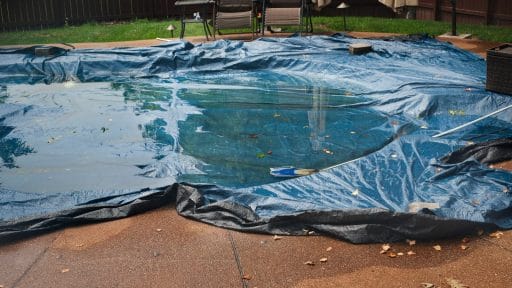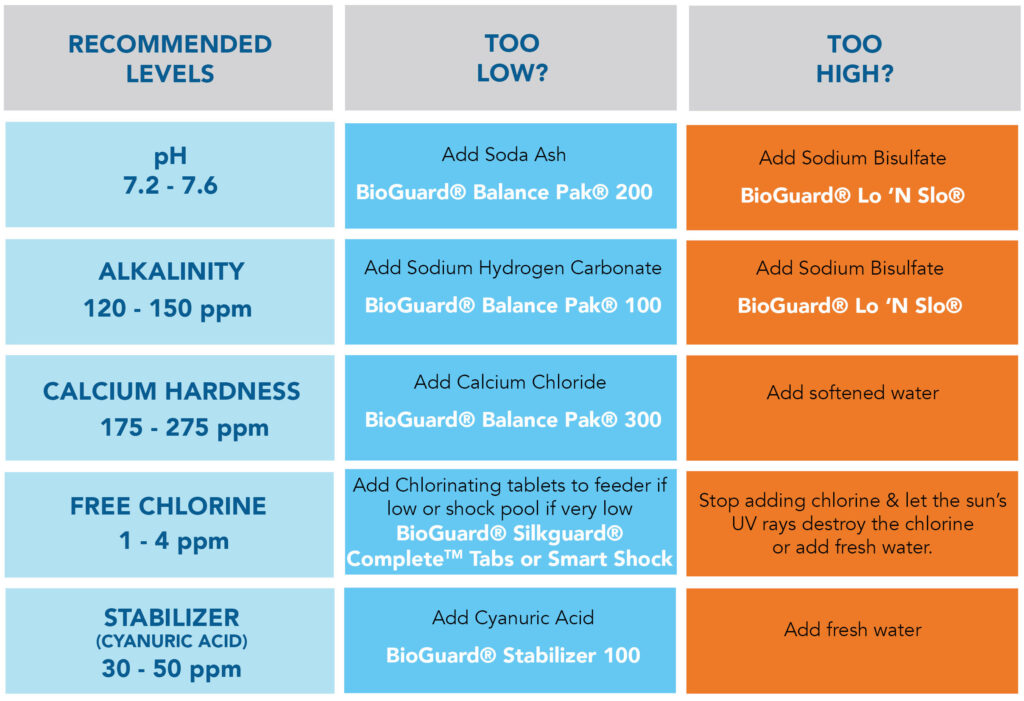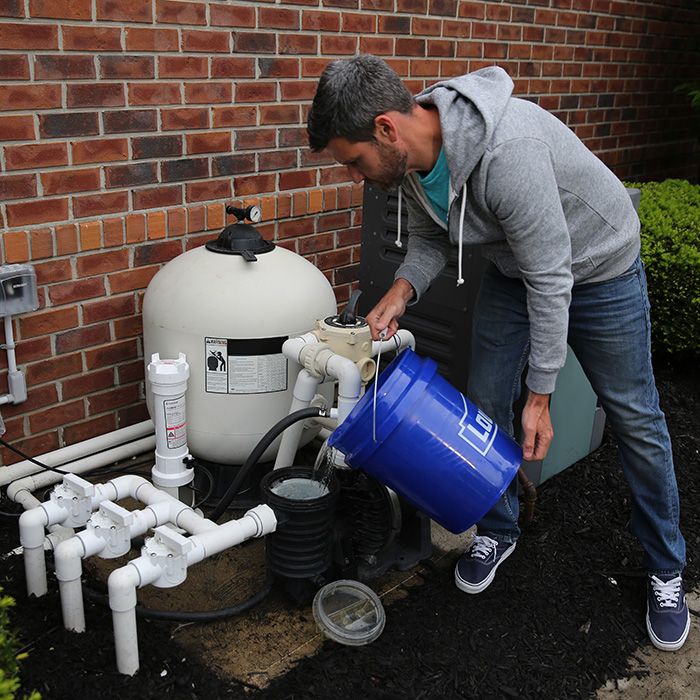Among the secrets to managing your swimming pool is to close your pool at the end of the season the right way and if you do, then it makes the job of opening your pool in spring much easier and less expensive. Use this format when you decide it’s time to start. Using these proven techniques in the right sequence, you can open an Inground swimming Pool quickly, on a weekend or as little as 2 days. How do you open an inground pool with a sand filter?
- Remove Pool Cover-Clean-Store away
- Re-assemble Filtering System-Add H2O level
- Set filter to Re-circulate
- Add quality Algaecide-brush & scrub pool walls & floor
- Mix & add a Flocculant-Let work overnight
- Vacuum settled debris to waste on the filter
- Set pH to 7.4-7.8 and alkalinity 100-120 ppm
- Super-chlorinate-Filter
This article explains how to open inground swimming pools. Nothing works quite as well on a winter pool as a good old-fashioned hand-cleaning with a garden hose used in conjunction with these fine pool products. This may be a tiny bit different but I have used this sequence for more than 30 years on my Inground swimming pool with great success.
Introduction:
To open an inground pool with a sand filter, start by removing the pool cover and cleaning any debris on the surface. Next, clean the filter by backwashing it to remove any built-up dirt or contaminants. Then, inspect the pool equipment (filtering system) for any signs of damage or wear and tear. After that, adjust the water chemistry by testing and balancing the pH, alkalinity, and sanitizer levels. Finally, start up the filtration system and monitor it closely to ensure proper operation as the pool water clears up. If you follow this procedure you can open an in-ground pool in a 2 day weekend.
How to Open Inground Pool with Sand Filter
Day 1
- Remove Pool Cover-Clean-Store away with pool cover accessories
- Start Cleaning (Brush and Scrub the Pool and Pool Area)

Begin by cleaning up the Pool Area- Once the winter is over you need to peel back the cover over your swimming pool and take a peek. If you cleaned the area that is under the cover along with the pool, then you will have less to do. Any organic matter that was trapped underneath usually can stain concrete or the filtering system that was exposed to the elements. So if you read my post 10 Easy Steps to Winterizing an Inground Pool you’ll see we started with Cleaning up the Pool Area.
There is no magic in a bottle that substitutes for keeping poolside along with the Filtering and any storage area that is exposed to the elements clean and manageable. This not only makes things easier but protects valuable equipment that keeps the Pool water, filter, and pumps in tip-top shape and ready to go. It’s time to open up your inground pool for another season.
Cleaning up the pool area after winter is an essential part of preparing for the swimming season. Here’s a comprehensive list of steps to help you get your pool area ready:
- Remove Debris: Start by removing any leaves, twigs, branches, or other debris that may have accumulated on the pool cover and in the surrounding area. Use a leaf skimmer, pool brush, or leaf blower to clear away debris efficiently.
- Remove Pool Cover: Carefully remove the pool cover, taking care not to let any debris fall into the water. Clean the cover with a mild detergent and water, then allow it to dry thoroughly before storing it in a dry, cool place.
- Inspect Pool Cover: While removing the cover, inspect it for any signs of damage or wear. Look for tears, holes, or weakened areas that may need repair or replacement before storing it for the season.
- Clean and Store Winter Accessories: If you use any winterizing accessories such as water bags, air pillows, or pool noodles, clean them thoroughly with mild soap and water before storing them away for next winter.
- Skim and Vacuum Pool: Use a pool skimmer to remove any remaining debris floating on the surface of the water. Then, vacuum the pool to remove dirt, leaves, and other debris that may have settled on the bottom.
- Check Water Level: Check the water level in the pool and add water if necessary to bring it to the proper level. Be sure not to overfill the pool.
- Brush and Scrub Pool Surfaces: Use a pool brush to scrub the walls and floor of the pool to remove any algae, dirt, or other residue. Pay special attention to corners, steps, and other hard-to-reach areas.
- Clean Filters and Pump: Remove and clean the pool filters and pump according to the manufacturer’s instructions. This helps ensure proper filtration and circulation of the water.
- Inspect Equipment: Check all pool equipment, including the pump, filter, heater, and any other components, for signs of damage or wear. Replace or repair any damaged parts as needed.
- Check Safety Equipment: Inspect safety equipment such as ladders, handrails, and diving boards for any damage or corrosion. Repair or replace any worn or damaged parts to ensure safe access to the pool.
- Re-install Pool Light
- Tidy Up Surrounding Area: Finally, tidy up the pool area by trimming back any overgrown plants or shrubs, sweeping or hosing down walkways and pool decks, and arranging pool furniture and accessories.
By following these steps, you can effectively clean up your pool area after winter on a weekend and prepare it for a safe and enjoyable swimming season.
Pool Opening Steps-Filtering System
- Re-assemble the Filtering system
- Open Plugs on the Filtering System(discharge and suction lines)
- Close Plugs on the Pump and Filter(air pressure gauge)
- Power Up
Before the winter you hopefully blew out the pool lines to prevent freezing and drained the filter and heater. Uncover the pump, and add the baskets, plugs for the pump, and pressure gauges. Attach the Backwash Hose back to the filter. Attach the vacuum. Power on the breakers and prime the pump through the vacuum.
The more you physically remove the less amount you have to try to vacuum out of the inside of the Pool which will only be harder, longer, and waste more energy. Organic material absorbs and wastes chemicals. Leaves and twigs inside the swimming pool or debris on the pool walls and floor suck up and waste chemicals. Get it Out!
*If antifreeze was added to your skimmer for winterization: Begin the process of evacuating it. If you have a DE or sand filter, turn the handle of your multiport valve to “waste.” This will push all of the antifreeze to the waste line as the pump runs. For a cartridge filter, simply use a dry shop vacuum on the skimmer line to pull out the antifreeze.
Pool Opening Steps Filter and Pump
- Power Up Filter and Pump-Set timer
- Re-circulate the Filtering System– Once the inside of the Pool is clean, turn the Filtering system on and set the filter to Recirculate.
Allows it to be vacuumed into the filter or out to waste and working all while the Pool is circulating all night long. It works faster on the higher side of pH 7.4 and 7.8.
You can bump it if you want to so that the Pool settles out more thoroughly at its optimum level. This is why I don’t adjust Alkalinity until afterward. Adjust the Ph a pinch and let the Flocculant work overnight. When you wake, your Pool will have a strange blue glow to it and all the particles of algae and anything else that was involved with the cloudy water will be settled out on the floor of the pool.
Pool Opening Steps Water Chemistry
Day 2
- Set filter to Re-circulate

Opening Your Inground Pool for the Season - Add quality Algaecide-brush & scrub pool walls & floor
- Mix & add a Flocculant-Let work overnight
- Vacumn
Vacuum the Pool- Now that the water clarity is maximum you’ll be able to see the settled out collection of floc and debris that you can vacuum directly off the bottom. You can take the biggest collection and vacuum the debris to waste then switch over to filter at your filtering system at continue to vacuum the rest of the pool.
Balance the Pool’s Water Chemistry- water chemistry dictates the health of the water in your pool. A proper pH level makes the water comfortable and keeps it from losing its sanitizing capability. A person’s tears have a pH of about 7.5 pH. If the pH is too low it can bother a swimmer’s skin and eyes.
If the pH is too high the water can be destructive to the swimming pool. High pH creates cloudy water in your pool and more importantly, if the pH is too high or low it will affect pool shock chlorine from sanitizing capability. This is the #1 reason that pH is tested throughout the week along with the Chlorine residual.
There are 2 tests you need to run to keep your pool from turning green and becoming uncontrollable. Just like in most articles about keeping your Pool no matter what kind of pool you own, the most important test that you run is TA at the beginning of the season when Testing Pool Water.
Pool Opening Steps Pool Testing
- Balance Pool Chemistry
- Start Filtration
Recommended Levels:
- Alkalinity 100-120 ppm
- Set pH to 7.4-7.8
- Super-chlorinate
- Algaecide
Total Alkalinity or TA.-In swimming pool water or any kind of water Alkalinity is an important step in keeping stability and chemical working especially chlorine. Water contains ionic compounds that are Alkaline in nature. They act as a buffer for keeping the pH in your pool from slipping. Think of it as a muscle for pH. The stronger the muscle in pH the less chance that it moves up or down leaving that ideal range in pH that is needed for the optimum level to keep your pool water sanitized properly
 Retest- The acceptable range for Total Alkalinity levels is between 90-140 ppm, however, the ideal range is between 100 to 120 ppm. You should check the total alkalinity levels once a week using a simple test kit.
Retest- The acceptable range for Total Alkalinity levels is between 90-140 ppm, however, the ideal range is between 100 to 120 ppm. You should check the total alkalinity levels once a week using a simple test kit.
If your Total Alkalinity is outside of this range, then adjust the total alkalinity by adding sodium bicarbonate baking soda to raise it or sodium bisulfate dry acid to lower it. Be sure to replace the reagents in your test kit every season for the best results.
Now that you adjusted Alkalinity wait about 4-6 hours and adjust the pH and chlorine along with total hardness in swimming pools is a measure of all the dissolved minerals such as calcium, magnesium, and sodium. The recommended level for calcium hardness is 200 – 400 ppm and both high and low levels result in swimming pool problems.
If you try and buy it at a discount you will just need more. With something like this product, you will get a better result and won’t have to buy and waste more time. This Algaeside only takes around 16 oz. per 10,000 gallons.
You won’t use all of it even if you are scrubbing and cleaning the floors and walls of the pool for the first time since last season. It’s not affected by pH and since your pool won’t be stabilized yet, well then there’s one thing left to worry about.
Use your appropriate amount of Algaecide initially and save the rest for regular maintenance either once a week or every other week according to the manufacturer’s directions as a preventative before Algae blooms appear in your pool or if you mess up and need to start from scratch. Make sure to brush your pool’s walls and floors on the top and sides of the steps if there are some.
Adjust pH and Superchlorinate- For the chlorine to work its best, the pH comes into play so adjust it accordingly to 7.2-7.6 then add Superclorinate to the pool water. Again try and get the best quality chemicals because if you try and save money and get a deal, you most probably got what was leftover from last year. Use new Reagents for Test Kits.
Super chlorinate with a strong quality product. Check the back of the bag or container for the amount of Available Chlorine 70% is good and the percent Sodium Hypochlorite aims for 70- 75% also look for a fast-dissolving Shock that will dissolve before it has a chance to lay on the bottom of the pool. Broadcast the Shock Chlorine as you walk around the Pool and of course, pay attention to Algae spots and the deep middle part of the pool. The Pool should be a cloudy white color.
Pool Season Maintenance Steps
Once owners open up their pools they should set up and develop a maintenance plan where they can make time to put in a few hours a week for the physical process part of keeping swimming whether it’s an in-ground or smaller Above-ground Swimming Pool. Brush the inside area of the pool.
This will allow the filter to pick up organic material that hides throughout an underground pool. Concrete, Plaster, and Cement have crevices and dimples where material can cloud your pool. Algae can hide in small places where they can colonize and develop. This affects chlorine and pH then eventually the whole pool.
It’s very important that Scrubbing and Brushing are added to the pool care process and be done at least once a week as part of the maintenance plan that you decide on. It will save you money throughout the season. You can use what’s left of your Flocculant or a Clarifier to help any material settle out to the bottom of the pool.
This will open up hiding places and make it easily accessible for vacuuming. Buy a quality pool vacuum you won’t regret it. Check out our recommended pool vacuum on Amazon- Dolphin Nautilus CC Plus Automatic Robotic Pool Cleaner
Conclusion:
In conclusion, maintaining a clean and well-functioning pool requires regular care and attention to ensure a safe and enjoyable swimming experience. By following a consistent maintenance routine, including cleaning, chemical balancing, and equipment inspection, you can keep your pool in optimal condition throughout the swimming season.
Addressing common issues such as debris accumulation, algae growth, cloudy water, and equipment maintenance promptly and effectively is key to preventing larger problems and costly repairs down the line. Additionally, proper winterization procedures are essential for protecting your pool during the colder months and ensuring it’s ready for use when the weather warms up again. This is the secret to opening your pool in the Spring!
Whether you’re a seasoned pool owner or new to pool maintenance, staying informed about best practices and seeking professional advice when needed can help you keep your pool clean, safe, and inviting for family and friends to enjoy. Remember, a well-maintained pool not only enhances your outdoor living space but also provides a refreshing retreat for relaxation and recreation. With dedication and proper care, you can maximize the enjoyment of your pool for years to come.
Have a Great Summer!
References:
Dengarden-How to Open an Inground Swimming Pool
FAQ’s
- How often should I clean my pool? It’s recommended to clean your pool at least once a week to remove debris, brush the walls and floor, and vacuum if necessary. Additionally, regular maintenance tasks such as checking and adjusting chemical levels should be done consistently.
- What chemicals do I need to maintain my pool? The primary chemicals needed to maintain a pool include chlorine (or alternative sanitizers), pH adjusters (such as pH increaser or pH decreaser), alkalinity increaser, calcium hardness increaser (if needed), and shock treatment. It’s important to regularly test your pool water and adjust chemical levels as needed to keep it balanced and safe for swimming.
- How do I prevent algae growth in my pool? To prevent algae growth, it’s essential to maintain proper water chemistry, including adequate chlorine levels and pH balance. Regularly brushing and vacuuming the pool, along with proper filtration and circulation, can also help prevent algae growth. Additionally, using an algaecide as a preventive measure can be beneficial, especially during the warmer months.
- How often should I backwash my pool filter? The frequency of backwashing your pool filter depends on several factors, including the type and size of the filter, the size of your pool, and the amount of debris and contaminants present in the water. As a general guideline, you should backwash your filter when the pressure gauge indicates a 7-10 psi increase over the clean pressure, or when the flow rate decreases noticeably.
- How do I winterize my pool? Winterizing your pool involves several steps to protect it from damage during the colder months. This typically includes balancing the water chemistry, lowering the water level, draining and winterizing the plumbing lines, adding winterizing chemicals, covering the pool with a winter cover, and performing any necessary equipment maintenance. It’s important to follow a comprehensive winterization checklist to ensure your pool is properly prepared for winter.



